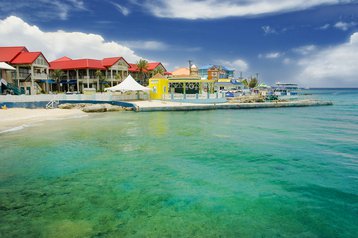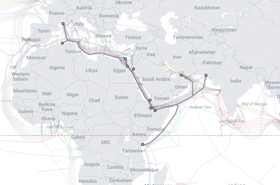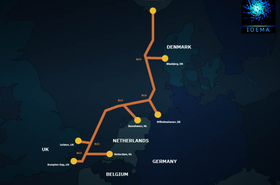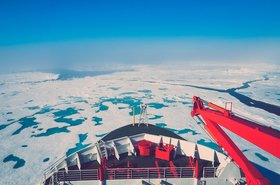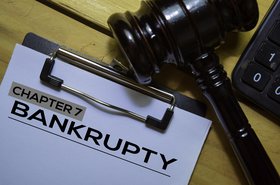The Cayman Islands is planning to deploy a new subsea cable.
The government first mooted plans for a new cable in 2022, and looks to be moving forward with the proposal.
Ranulf Scarbrough, who leads the Cayman Islands Submarine Cable Modernisation Project for the Cayman Islands Government, presented the self-governing British Overseas Territory’s plans at the Subsea Networks EMEA conference in London last week.
The Caribbean islands are currently served by two subsea cables; the unrepeatered Cayman-Jamaica Fiber System (CJFS) connecting two of the three Cayman islands to Jamaica; and the Maya-1 cable linking Columbia to Florida via Panama, Mexico, Honduras, and Costa Rica.
The two cables both date back to the dotcom boom days – the Liberty-owned CJFS from 1997, and the consortium-owned Maya-1 from 2000. Scarbrough noted that there seems to be little appetite from incumbents to replace the current two cables.
The Cayman government is hoping to deploy a new cable to increase resiliency – Scarbrough said Maya-1 was cut several times in 2020, and CJFS suffered issues late last year. He said a ten-day cable outage could cost the island £150-200 million.
“Both systems are aging, and the Cayman Islands Government (CIG) has no certainty or control with regard to the future of either of the existing cables. The CIG considers subsea cables critical national infrastructure, and the lack of certainty about their future introduces various risks to the islands, and represents a threat to the islands’ future,” a business case report from the government said.
There is a monopoly on subsea connectivity to the island; CJFS is owned by Liberty, and the landing party for Maya-1 in the Cayman Islands, Flow, is also owned by Liberty via its Cable and Wireless (C&W) unit. Connectivity costs are high on the islands, so it's also hoped a new cable will bring down the price for companies and consumers.
Scarbrough said there had been a “market failure” and so the government has decided to intervene and start the process to deploy a new cable that would likely link the territory to Florida.
The 264-square-kilometer (102-square-mile) territory – comprising the three islands of Grand Cayman, Cayman Brac, and Little Cayman – is located south of Cuba and north-east of Honduras, between Jamaica and Mexico's Yucatán Peninsula.
More than 96 percent of the Cayman's 70,000 population live on Grand Cayman. At the moment, connectivity to Cayman Brac is provided from Grand Cayman via the CJFS cable. Connectivity to Little Cayman is provided by radio from Cayman Brac. It’s unclear if the government would be seeking a cable to connect all three islands.
The government is exploring the potential to secure a branch on an upcoming third-party cable system in the area, such as the upcoming CSN-1 or GD-1/LN-1 systems, but that “creates challenges" if the government backs a project that doesn’t come to fruition, according to Scarbrough.
The preference seems to be a dedicated cable linking the island directly to the US. And while the government is open to partnering, it may set up a dedicated arms-length company to own and operate the cable if no partner can be found.
Scarbrough said the government will be putting out an RFP within the next 12 months; the business case report from March suggested a cable could potentially be brought into service sometime between Q3 2025 and Q4 2026, though the earlier start date was based on a 2023 construction start.
Desired cable capacity and expected costs were redacted from the document.
The report assumes the cable would land in Grand Cayman. To save costs, the document notes a new cable would likely use an existing local landing party, rather than build a new cable landing station. Maya-1 lands at Half Moon Bay on Grand Cayman.
Johany "Jay" Ebanks, Minister of Planning, Agriculture, Housing, Infrastructure, Transport, and Development, said in March: "The Cayman Islands Subsea Cable Project is more than an infrastructure initiative; it's a commitment to our future. By releasing this business case to the public, we are underscoring our dedication to transparency, accountability, and our unwavering belief in the power of digital connectivity to drive progress. I am confident that this project will serve as a lighthouse, guiding our islands towards unprecedented growth and connectivity."
Cable & Wireless has previously spoken out against a third cable to the island, saying the company has made “continued investment” in the Maya-1 cable.
“While a third cable with a direct link to the United States would bring an additional path and capacity to the marketplace, it would not provide material improvement in latency to the USA and beyond,” the company said in 2020.
Other potential projects to connect the territory have been suggested but never materialized.
Around 2017, the new Deep Blue Cable was due to connect the Cayman Islands, while BNAmericas has previously reported on an Aurora cable project that would have followed a similar route to Maya-1, but the project status hasn’t been updated since 2022.
Seaborn Networks – which operates and has capacity on multiple cables connecting the US to South America – has reportedly previously shown interest in connecting the Cayman Islands.

